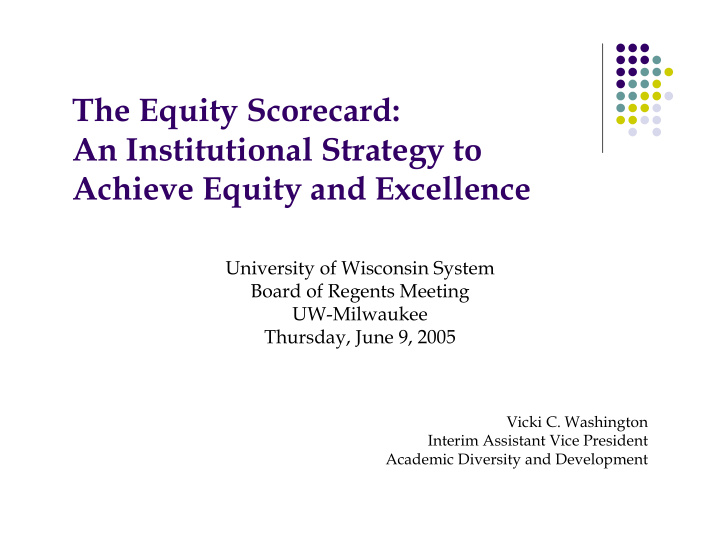



The Equity Scorecard: An Institutional Strategy to Achieve Equity and Excellence University of Wisconsin System Board of Regents Meeting UW-Milwaukee Thursday, June 9, 2005 Vicki C. Washington Interim Assistant Vice President Academic Diversity and Development
Overview of Presentation � What Is The Equity Scorecard? � What Is Equity? � Why Now? � How It Works � Next Steps � Examples � UW-Parkside and UW-Madison
The Diversity Scorecard is a tool and a process to help campuses assess their effectiveness in providing historically underrepresented students with the credentials they will need to gain economic, social, and political power.” Estela Mara Bensimon
What Is The Equity Scorecard? � A comprehensive campus-based strategy for assessing and improving institutional effectiveness � A holistic and systematic strategy that spotlights and prioritizes race/ethnic (and other) inequities for action planning � Provides a solid base of information for closing the access and achievement gaps
It Is Not… � A Mandate � A Report Card � A Uniformity Driven Assessment Model � A Replacement of Existing Assessment and Evaluation Efforts
Core Principle of The Equity (Diversity) Scorecard …“Evidence, [i.e., factual data] about inequities in educational outcomes [access, enrollments, retention, excellence, graduation]…can have a powerful effect upon faculty members, administrators, counselors, and others and their motivation to solve them.” Estela Mara Bensimon
What Is Equity? “Equity is achieved when students of color succeed in any variety of measures relative to their representation (including access and excellence) on campus.” “Why Equity Matters: Implications for a Democracy,” Diversity Scorecard Project, Center for Urban Education University of Southern California
Why Now? In Order To… � Address educational outcomes stratified by race and income � Reap the benefits of increasing economic returns � Equip all students for a knowledge-based economy � Foster social, political, and economic stability of Wisconsin and the country � Eliminate educational inequities � Increase institutional accountability
The Accountability Side of Diversity “…[These] are evidence based practices that will make individuals more conscious of the state of educational outcomes for historically underserved students and will enable them to act purposefully.” Estela Mara Bensimon The Accountability Side of Diversity
How It Works � Awareness: Engage in institutional self-assessment to provide a clear and unambiguous picture of inequities � Interpretation: Analyze and integrate the meaning of the inequities � Action: Develop strategic actions to achieve equity in educational outcomes based on data, not assumptions
When Data Speak “It is said, ‘What gets measured gets noticed’. Team members were skeptical at first. The act of breaking data down by race and ethnicity has provided many ‘aha’ moments.” Estela Mara Bensimon Through the simple act of disaggregating existing data, institutions are able to locate the most critical gaps in the academic performances of students of color and other underrepresented students.
The Equity Scorecard ACCESS Objective Baseline Improvement Equity Target RETENTION EXCELLENCE Equity in Objective Objective Educational Outcomes Baseline Improvement Equity Baseline Improvement Equity Target Target INSTITUTIONAL RECEPTIVITY Objective Baseline Improvement Equity Target
The Process � Create campus evidence teams � Analyze existing data through the four perspectives � Develop Scorecard � Share results
Access Indicators � In what programs and majors are underrepresented students enrolled? � Do underrepresented students have access to important career enhancing academic programs like internships or fellowships? � What access do underrepresented students have to financial support? � What access do underrepresented students, at four- year colleges, have to graduate and professional schools?
Retention Indicators � What are the comparative retention rates for underrepresented students by program? � Do underrepresented students disproportionately withdraw from “hot” programs like engineering or computer sciences? � How successful are underrepresented students in completing basic skills courses?
Institutional Receptivity Indicators � How well is our postsecondary education system serving the needs of students of color? � Do educational outcomes for students of color in specific areas reveal an equity gap? � Does the composition of the faculty enhance diversity, and correspond to the racial and ethnic composition of the student body?
Excellence Indicators � Access � Which majors or courses function as “gatekeepers” for some students and “gateways” for others? � Why are African American students concentrated in certain majors, such as education, social work, business? � Achievement � What are the comparative completion rates in highly competitive programs? � What is the pool of high-achieving under-represented students eligible for graduate study?
Next Steps � Build capacity of UW System Administration to facilitate implementation of Scorecard � Identify current assessment practices at UW institutions � Explore options for piloting the Equity Scorecard at UW institutions
Closing… “We must deliberately and energetically remove the conditions that deny or impede equitable outcomes for all students. The Diversity Scorecard is a tool and a process to help campuses assess their effectiveness in providing historically underrepresented students with the credentials they will need to gain economic, social, and political power.” Estela Mara Bensimon, “The Diversity Scorecard: A Learning Approach to Institutional Change,” Change Magazine (January/February 2004).
Recommend
More recommend